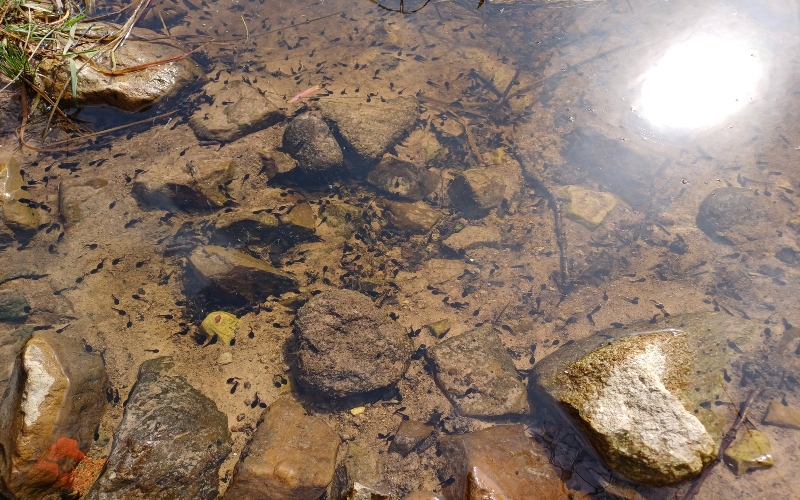

Natural Flood Management (NFM) Scheme
Natural Flood Management (NFM) Scheme
This innovative Natural Flood Management scheme in Ammanford is a nature-based flood alleviation scheme that provides a higher level of flood protection for more than 20 properties situated around Margaret Street.
Previous Flooding Issues
The main risk of flooding in the area arises from fluvial and surface water flows exceeding the watercourse capacity, potentially impacting key assets such as the Amman Valley Comprehensive School, the Ammanford Catholic Church, and the Town Hall on Iscennen road.
The watercourse itself runs from the upper hills near the confluence of the river Amman and river Loughor, down into urban Ammanford along Margaret Street, where the watercourse is culverted in multiple locations. This further increases the risk of flooding through the potential of blockages or collapses occurring.
Therefore, flood mitigation measures were necessary to protect the local community from additional flood risk, particularly under future climate change conditions.
The Flood Alleviation Scheme – Natural Flood Management
The Natural Flood Management (NFM) principle involves working with natural processes to reduce the risk of flooding and coastal erosion, by protecting, restoring, and mimicking the natural environment and processes.
- Protect – retain existing natural features for watercourses and landscape
- Restore – replace and reinstate features to promote natural hydrological processes – land management, decrease runoff potential and attenuate flood flows
- Mimic – add in NFM features to replicate natural features and processes
Design of the 13 leaky dams and 5 flood storage areas commenced in February 2021 with construction works completed in Spring 2024. The NFM features use existing topography and local materials to reduce fluvial flows, and attenuate flood water through the watercourse, providing natural solutions to achieve multiple benefits for the local community.
Ongoing monitoring includes telemetry to monitor water levels and storage provided, biodiversity surveys of local wildlife, and regular visual inspection and photo-logging of the NFM elements.

Natural Flood Management (NFM) Scheme
This innovative Natural Flood Management scheme in Ammanford is a nature-based flood alleviation scheme that provides a higher level of flood protection for more than 20 properties situated around Margaret Street.
Previous Flooding Issues
The main risk of flooding in the area arises from fluvial and surface water flows exceeding the watercourse capacity, potentially impacting key assets such as the Amman Valley Comprehensive School, the Ammanford Catholic Church, and the Town Hall on Iscennen road.
The watercourse itself runs from the upper hills near the confluence of the river Amman and river Loughor, down into urban Ammanford along Margaret Street, where the watercourse is culverted in multiple locations. This further increases the risk of flooding through the potential of blockages or collapses occurring.
Therefore, flood mitigation measures were necessary to protect the local community from additional flood risk, particularly under future climate change conditions.
The Flood Alleviation Scheme – Natural Flood Management
The Natural Flood Management (NFM) principle involves working with natural processes to reduce the risk of flooding and coastal erosion, by protecting, restoring, and mimicking the natural environment and processes.
- Protect – retain existing natural features for watercourses and landscape
- Restore – replace and reinstate features to promote natural hydrological processes – land management, decrease runoff potential and attenuate flood flows
- Mimic – add in NFM features to replicate natural features and processes
Design of the 13 leaky dams and 5 flood storage areas commenced in February 2021 with construction works completed in Spring 2024. The NFM features use existing topography and local materials to reduce fluvial flows, and attenuate flood water through the watercourse, providing natural solutions to achieve multiple benefits for the local community.
Ongoing monitoring includes telemetry to monitor water levels and storage provided, biodiversity surveys of local wildlife, and regular visual inspection and photo-logging of the NFM elements.
Benefit
This scheme provides a higher level of flood risk protection for more than 20 properties downstream of the project, by reducing peak flood levels and flows, attenuating flood water, and reducing erosion along the watercourse. All of these elements work to reduce long term flood risk within a high risk community, while building resilience within the community and ecosystem against climate change.
While primarily functioning to reduce flood risk within the catchment, the scheme also creates habitats for local biodiversity, supporting protected wildlife within the Ammanford area, as well as providing educational benefits for learners in the local school who have been involved in the ongoing monitoring of the scheme.
Funding
The design and construction works cost a total of £150,000, which was fully funded by the Welsh Government Natural Flood Management Pilot Programme. This forms part of a wider National flood risk strategy to provide flood mitigation using nature based solutions, to promote net gains in biodiversity and build resilience to climate change.
Images of Project

Benefit
This scheme provides a higher level of flood risk protection for more than 20 properties downstream of the project, by reducing peak flood levels and flows, attenuating flood water, and reducing erosion along the watercourse. All of these elements work to reduce long term flood risk within a high risk community, while building resilience within the community and ecosystem against climate change.
While primarily functioning to reduce flood risk within the catchment, the scheme also creates habitats for local biodiversity, supporting protected wildlife within the Ammanford area, as well as providing educational benefits for learners in the local school who have been involved in the ongoing monitoring of the scheme.
Funding
The design and construction works cost a total of £150,000, which was fully funded by the Welsh Government Natural Flood Management Pilot Programme. This forms part of a wider National flood risk strategy to provide flood mitigation using nature based solutions, to promote net gains in biodiversity and build resilience to climate change.
Images of Project














